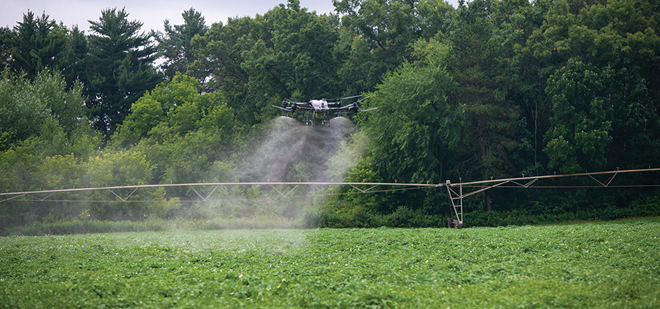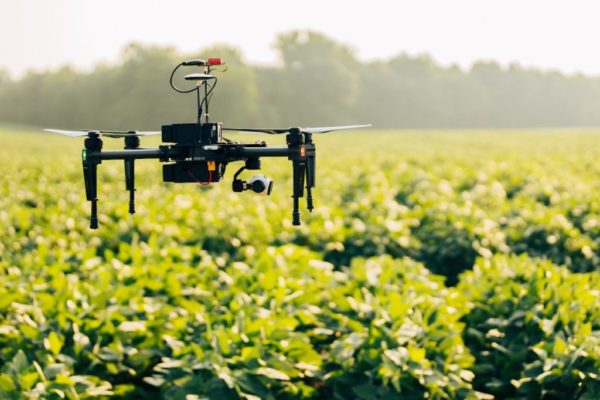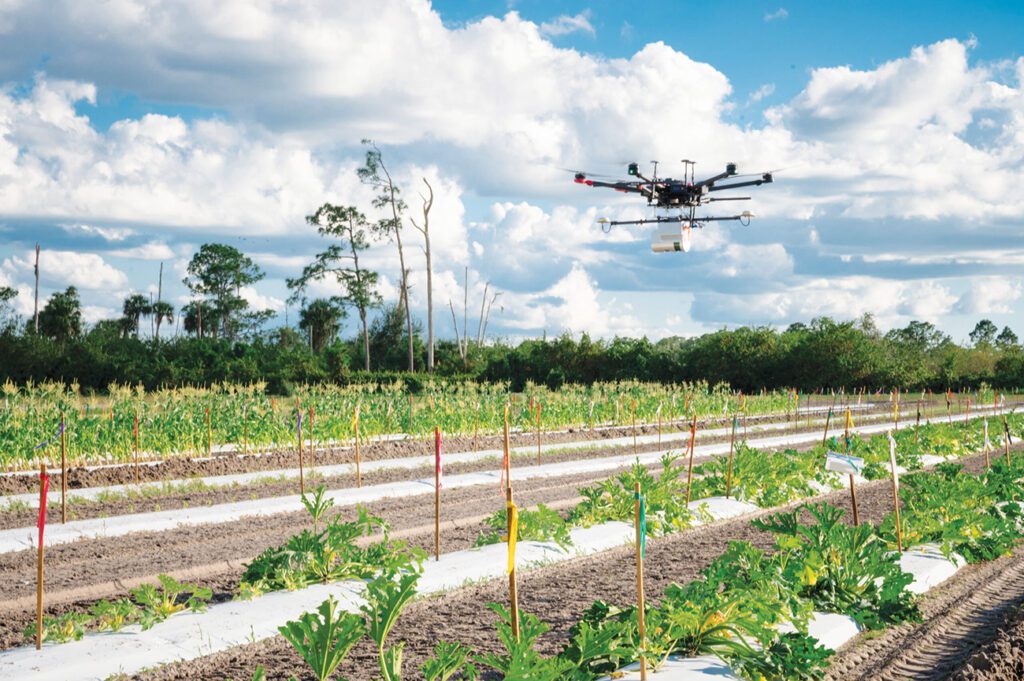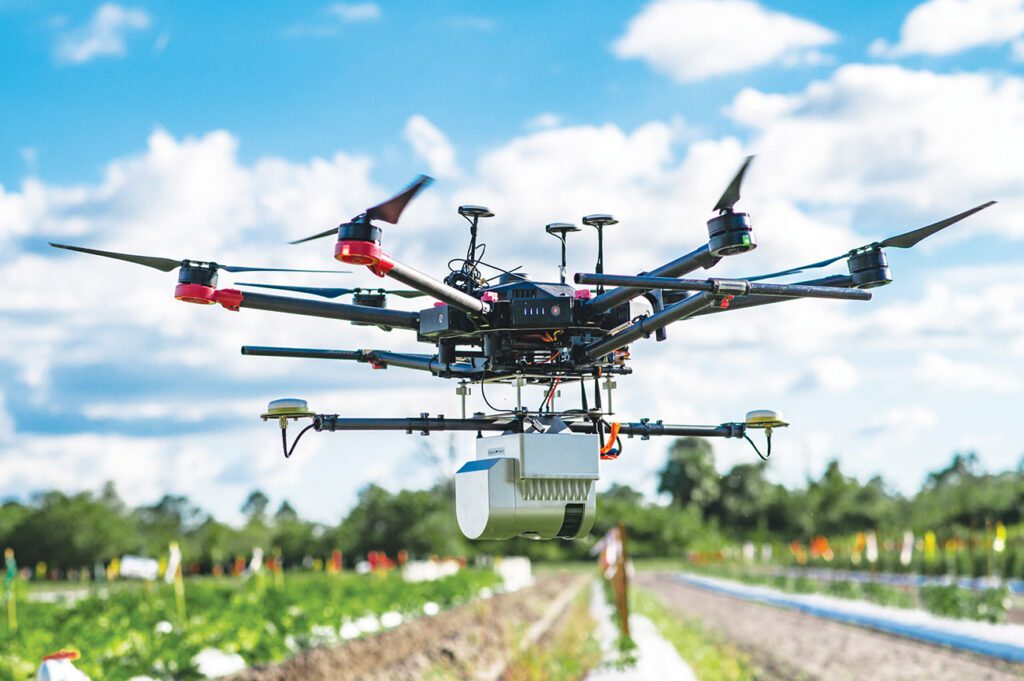

Dec 17, 2023Drones help scout crops, but growers must consider costs
Drones help East Coast growers who typically don’t enjoy access to aerial applicator services, which prefer to service the larger row crop fields in the Midwest, said Kenny Strong, owner of Accurate Ag Spraying LLC.
The Smithsburg, Maryland, drone seller’s customers range from growers who plant 14 acres to those overseeing 4,000 acres.
“Drones are a tool that basically any size grower can use,” he said. “The drones have come a long way from the days of being a 2-acre machine. Now, we’re up to 10-and-a-half gallons, and the next model that’s going to be coming out will be 13 gallons, so the size of the drone just continues to increase. The efficiencies went from a couple of acres an hour to up to 30 acres an hour. It’s really spiraled out of control in a great way.”
Economies of scale
Despite today’s drones being less expensive, owning and operating can represent a significant grower investment. Growers advise weighing the economies of scale and recouping their capital investments by passing that cost into the first year of operation.


“You have to have the economies of scale, passing that cost on in your first year, and recouping your capital investment to where you can sell that platform and be able to afford to do so and not want to get left behind,” said Geoff Klein, irrigation manager at Bullseye Farms in Woodland, California, which grows nuts, tomatoes and cucumbers.
Though entry-level drones can cost $400-$1,500, those to be regularly used on the farm can begin in the $2,500 range. Longer flight times with larger platforms covering more acres can hike yearly leasing to $8,000.
Spray platforms with higher capacity payloads can cost $30,000-$40,000 a year, said Martin Hein, of Visalia, California’s Hein Ranch and partner with FlyingAg, which sells and advises farmers on UAS technology.
Owning vs. contracting
Paying a worker to fly a drone on a farm with a couple thousand acres can run $10 to $15 images that chart a crop’s progress through the entire season. But that compares to contracting with a supplier to provide seven aerial images and brief narratives that can cost up to $70 an acre per year, Hein said.
Van Whitehurst of Whitehurst Cattle Co., in Williston, Florida, spent $2,000 on his first drone to map watermelon fields. Today’s lightweight models, which cost about $400, can conduct simple field mapping, he said.
A $400 drone from Costco contains all a grower needs for aerial surveillance, Klein said. The addition of batteries and other accessories could bring the total to under $1,000. He estimates he would need to spend under $1,000 a year for software subscriptions.


At Hein Ranch, one drone with one operator can photograph 6,000 acres in two days.
“When you can fly 320 acres in 30 minutes, you know owning a drone starts to make sense,” Hein said.
In considering owning vs. contracting through a service, another factor to consider is control over flight scheduling, which could provide more flexibility in crop treatments.
One supplier Bullseye used to work with would notify the farm when it planned to fly over the groves the following month. That required working backwards in factoring when Bullseye applied fertilizer and water to accommodate the service’s flight schedule and was a reason Klein said he chose to run his own drones, which would provide more control of when it would apply inputs.
Despite a high initial investment, owning can be cost-effective in the long run, particularly if a grower requires frequent or ongoing aerial data collection, said Chad Colby, agricultural technologist consultant and owner of ColbyAgTech.com. Contracting the service, however, transfers the burden of maintenance, repairs and compliance to the service provider, reducing grower responsibility and allowing them to focus on core operations, he said.
Providers may charge fees for services beyond standard offerings, including customized analysis and flight plans, specific images, data processing and capture settings. Expect to be charged for flight set up and take down and for additional equipment or sensors and add-on services.
Additionally, some providers may require insurance coverage and liabilities for their operations, while others may require that growers add the drone company as an additional insured party. Growers should clarify insurance-related responsibilities and other costs up front, he said.
There are times when drones may not make sense, said Michael Reinke, Michigan State University Extension viticulture specialist and integrated pest management educator for fruits and vegetables.


“If you want to use a drone for scouting, identifying issues or site planning, I think it could be worth it to buy a drone and some mapping software and try it out,” he said. “If you are interested in an application drone, I would seriously think about contracting out at least at first to see if it is a fit for your farm before you look into the costs and certification challenges. In addition to the several layers of certification, there is the up-front cost.”
The decision to buy vs. renting can depend on an operation’s size.
“One of the greatest advantages of using drones is their scalability, making aerial imagery applicable to both large and small farms,” said Adityah Singh, assistant professor of agricultural and biological engineering at the University of Florida. “The investment in drones or drone services can be tailored to the specific needs and scale of the application, providing flexibility and cost effectiveness in various contexts.”
Large or small?
Larger acreage operators would likely benefit more by owning than smaller farms, Klein said. If a grower uses a drone for only one or two fields, it could make more sense to pay someone for the service, despite possibly costing a little more in the end, he said. The cost of software subscriptions would require the grower to fly the drones more.
“It really depends on your scale,” Klein said. “If you’re a larger grower, it would make sense to have your own as long as you have someone who can run and understand it and know what you will do with the data.”
A basic subscription allows a limited number of image uploads and requires more time as a grower transitions to a business or commercial account as drone acreage increases. The higher subscription costs allow growers to become higher priorities with drone companies, who can provide images in a matter of minutes or hours, ready to forward to field supervisors in larger growing operations or grower clients, Klein said.
“If you buy it and you don’t use it, then it’s pretty much worthless anyway,” Klein said. “And then you’ve wasted all that money. So, make sure you have enough ground that you want to use it on, and then have someone who is actually going to be able to use it. And then, someone who can make change decisions based on those images to make the information valuable.”
— Doug Ohlemeier, assistant editor
Top photo: Drones can supply images that help growers more precisely identify areas of concern. Photo courtesy of Heartland Farms.














